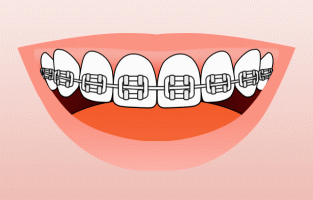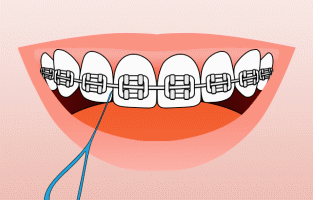
Life with Braces
Check out our Youtube page for videos of some of the orthodontic appliances we use.
Now that you have your braces, how do you take care of them? It's important for you to know how to properly take care of your braces throughout your entire orthodontic treatment. eating with braces
Eating with Braces
Don’t worry, you’ll be eating popcorn and snacking on potato chips again in no time! Before you can start enjoying some of the treats you love, however, you will need to take special care to avoid any foods that could damage your new appliances.
Foods to avoid with braces
- Chewy foods — bagels, licorice
- Crunchy foods — popcorn, chips, ice
- Sticky foods — caramel candies, chewing gum
- Hard foods — nuts, hard candies
- Foods that require biting into — corn on the cob, apples, carrots
Foods you CAN eat with braces
- Dairy — soft cheese, pudding, milk-based drinks
- Breads — soft tortillas, pancakes, muffins without nuts
- Grains — pasta, soft cooked rice
- Meats/poultry — soft cooked chicken, meatballs, lunch meats
- Seafood — tuna, salmon, crab cakes
- Vegetables — mashed potatoes, steamed spinach, beans
- Fruits — applesauce, bananas, fruit juice
- Treats — ice cream without nuts, milkshakes, Jell-O, soft cake
Soreness Caused by Braces and Appliances
When you first get your braces, you may notice that your teeth and mouth feel a little tender or sore. This is perfectly normal, and we promise your mouth will not be sore forever! To relieve the pain, we recommend dissolving one teaspoon of salt in eight ounces of lukewarm water. Swish and gargle this solution in your mouth for just a couple of minutes, but do not swallow the salt water.
If the pain is more severe and does not go away after rinsing, you can also try taking a pain reliever. Whatever you typically take for a headache will suffice.
It is not uncommon for your lips, cheeks, and tongue to become irritated for one to two weeks as they toughen up and become used to the braces. We would be happy to give you some wax you can put over the braces to lessen the tenderness.
Loose Teeth
If your teeth begin to feel a little loose, don’t worry; this is normal! Your braces must first loosen your teeth to move them into the right position. Once your teeth have been repositioned, they will no longer be loose.
Loose Wires and Bands
The wires and bands on your braces may come loose. If this happens, please contact us as soon as possible so we can check and repair your appliance. If any piece of your appliance comes off, be sure to save it and bring it to the office with you.
You can fix the loose wire temporarily by using the back of a spoon or the eraser end of a pencil to push the wire carefully and gently back into place. If the loose wire is causing irritation to your lips or cheeks, put wax or a wet cotton ball over it to relieve the pain.
Take Care of Your Appliances
Damaged appliances can increase the length of your treatment process, so be sure to take care of all your appliances. Your teeth and jaw can only move into their correct positions if you wear the rubber bands, headgear, retainer, or other appliances consistently as prescribed by our team.
Playing Sports with Braces
Game, set, and match — we have great news for athletes and musicians! You can still play sports and musical instruments even while undergoing orthodontic treatment. If you play sports, it’s recommended that you wear a mouthguard to protect your teeth and your appliance.
Brushing and Flossing
When you have braces, it’s vital to brush and floss after every meal in order to keep your teeth and gums healthy throughout your orthodontic treatment. If you need help choosing the right toothbrush, toothpaste, and dental floss, please ask us and we can help you choose the right products for your teeth and your appliance.
Brushing with Braces
Brush your teeth for two minutes after every meal with a soft-bristled, small-headed toothbrush and fluoride toothpaste. As an alternative, you can use a powered toothbrush to increase your brushing effectiveness.
Brush the outside and inside surfaces of your teeth using small, gentle, circular motions while positioning the head of the toothbrush at a 45-degree angle to the gum line. Brush your teeth’s chewing surfaces and the inside surface of your front teeth using short, gentle, back-and-forth motions.
Pay close attention to the areas around your brackets or other appliances.

Flossing with Braces
Flossing after every meal will help keep your teeth and braces clean, which will also keep your treatment time on track. To floss with braces, use a floss threader or special orthodontic floss to thread the floss behind each wire.
Wrap the ends of the floss around your pointer fingers of both hands, but leave a few inches of taut floss between them. Gently slide the floss between each set of teeth using a back and forth motion. Floss the sides of each tooth beneath the gum line to remove plaque and food particles. Repeat this process until you’ve flossed all of your teeth.
If you find your floss is not removing all the food particles between your teeth and around your braces, ask us about a water flosser!



 Website Powered by Sesame 24-7™
Website Powered by Sesame 24-7™